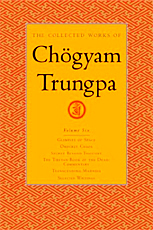About Chögyam Trungpa and His Collected Works:
Chögyam Trungpa (1939 - 1987), a Tibetan meditation master, teacher, and artist is widely known as one of the pioneers in bringing Buddhism to the West. He was born in eastern Tibet and was identified as the eleventh descendent in the line of Trungpa tulkus (incarnations of teachers). At age 18, this scholar was Supreme Abbot of the Surmang Monasteries. He fled to India when the Chinese invaded his homeland in 1959. In 1963, Chögyam Trungpa traveled to England where he attended Oxford University as a Spaulding Fellow, studying Western philosophy, religion, art, and language. He established the first Tibetan Buddhist center in Scotland in 1967.
In 1970, he was invited to teach in the United States; he settled down in Boulder, Colorado. Over the years, he established over 100 meditation centers in America, Canada, and Europe. Trungpa Rinpoche set up Shambhala International in 1973 to coordinate the activities of these centers. He also founded Naropa Institute (now Naropa University), an innovative college that combines contemplative studies with a liberal arts curriculum. A secular program for meditation called Shambhala Training was established in 1976. In 1986, Trungpa Rinpoche moved the center of his activities from Boulder to Halifax, Canada, where he died the following year.
Carolyn Rose Gimian, editor of The Essential Chögyam Trungpa (1999), is the compiler and editor of The Collected Works of Chögyam Trungpa. In each of these eight volumes, she provides an overview of the material.
About This Volume
Volume Six contains advanced teachings on the nature of mind and tantric experience. Chögyam Trungpa never shied away from difficult subjects even though those attending his seminars may not have been able to keep up with the complexity of his teachings on arcane aspects of Tibetan Buddhism. In "Transcending Madness," he discusses the six states of bardo. In "Secret Beyond Thought," he explores the meaning of the five chakras and the four karmas. In "The Tibetan Book of the Dead," he explains how this classic text sheds light on human psychology. Perhaps the most accessible essay in this collection is "Femininity" where Chögyam Trungpa examines the role of women in Buddhism. In the seminar presentations, this teacher stimulates his students with his thoughtful and challenging responses to their questions.
